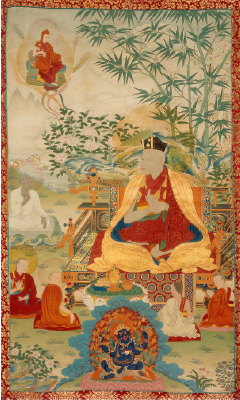Palden Düsum Khyenpa - (1110 - 1193)

Early Years: Born to a family of devoted Buddhist practitioners in Teshö in eastern Tibet, the boy who was to become known as the first Karmapa was called Gephel as a child. He first studied with his father, and became a knowledgeable and seasoned practitioner, even as a young child. He continued his education with other Buddhist teachers of the region.
First Teachers: Already quite learned by the age of twenty, he moved to Central Tibet, became a monk and spent the next twelve years or so engaging in study and meditation practices. He studied with very well known masters of the time, such as Chapa Chökyi Senge (1109-1169), a great logician and the founder of the debate system in Tibet, and Patsab Lotsawa Nyima Drakpa (1055-?), who translated many Madhyamaka texts (one of the highest schools of Buddhist philosophy) into Tibetan and was a great master of the Prasangika Madhyamaka tradition.
Training under Gampopa: At the age of thirty, he received teachings from Gampopa, the heart son of the greatest yogi in Tibetan history, Milarepa. Düsum Khyenpa first trained in the foundation practices of the Khadampa tradition and, following that, in the general philosophy of the sutras. This training in the basis of all Buddhist traditions established a pattern for all future Kagyüd followers by demonstrating the importance of establishing a correct basis of knowledge. This is true even when engaging in the most powerful of advanced Vajrayana practices. Düsum Khyenpa also received and unified the lineage teachings he received from Rechungpa and other students of Milarepa.The Karmapa's accomplishment in meditation and the practices transmitted to him by his teachers were greatly enhanced by his own natural compassion. His practice produced rapid results and great accomplishments, or siddhis. Such accomplishment is often perceived by followers as the ability to perform miraculous activity. In fact, the legends of the Karmapas through the ages speak of their ability, through the manifestation of this seemingly miraculous activity, to create a great sense of wonder and faith in their students. All the Karmapas have since been known for their ability to inspire, through their simple presence, this profound sense of wonder and faith in the reality of the accomplishment which is the fruition of the Buddhist path.
Establishing Monastic Seats:
- At the age of 55, Düsum Khyenpa founded a monastery at Kampo Nénang;
- at the age of 60, he started the Panphuk monastery in Lithang, in East Tibet.
- Later, at the age of 76, he established an important seat at Karma Gön, in eastern Tibet.
- At the age of 80, he established his main seat at Tsurphu, in the Tolung valley, a river which feeds into the Bhramaputra, in central Tibet.
The first Karmapa, Düsum Khyenpa, made predictions about future Karmapas. In particular, never seen before, he was the first Lama to present a prediction letter, detailing his future incarnation. He gave it to his main disciple, Drogön Rechen, whom he chose to become the next lineage-holder.Düsum Khyenpa passed away at the age of eighty-four.
Among his other main disciples were Taglungpa, founder of the Ta-lung Kagyüd, Tsangpa Gyare, founder of the Drukpa Kagyüd, and Lama Khadampa Desheg, founder of the Katok Nyingma lineage.
The principal student who held the lineage of the Golden Rosary from the First Karmapa was Drogön Rechen.
Excerpt from the official website of The Tsurphu Labrang





